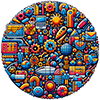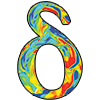SpaceClaim Training Course — Ep 01
Session 7
- Episode
- 01
- Run Time
- 14m 28s
- Published
- Oct 15, 2025
- Topic
- SpaceClaim
- Course Progress
- 0%
1. Overview
In this SpaceClaim training session, we’ll introduce one of the software’s most significant and versatile tools, known as the Pattern command. This command exists in two variants within the software: Linear Pattern and Circular Pattern. In this lesson, we’ll create a distinctive and practical geometry for each of these options.
As an example for the Linear Pattern, we’ll design a pin fin heat sink. Conversely, to better illustrate the Circular Pattern, we’ll model a gear component.
2. Pattern Utility
The Pattern command in SpaceClaim enables you to duplicate geometry in a systematic and organized manner within the design workspace. With this tool, you can generate multiple instances of a single base geometry along various directions (linear or circular), allowing you to rapidly construct complex and structured components. This capability proves especially beneficial for reducing design time and creating practical geometries.
3. Linear Pattern Functionality
The Linear Pattern command enables us to replicate geometry along a straight path. One of this tool’s excellent features in SpaceClaim is that you can implement it in either one-dimensional or two-dimensional arrangements.
In each of these dimensions, you can specify both the number of pattern instances you desire from your geometry, and the spacing between the objects.
4. Circular Pattern Functionality
The Circular Pattern command in SpaceClaim allows you to duplicate and replicate geometry along a circular trajectory. You can designate the number of repetitions, and the software will distribute them uniformly around a selected axis or center point. This feature proves particularly valuable for designing geometries such as gears, turbine blades, or circular bolt hole patterns.
5. Session Summary
Building upon the various commands we’ve mastered in previous sessions, such as the Pull and Move commands, and now in this session the Pattern command, combined with gaining advanced proficiency in the 2D sketching environment, from this point forward we anticipate being able to create more sophisticated, practical, and diverse geometries.
The content presented in this session actually serves as a supplement to the topics addressed in previous lessons and completes them. By integrating all these skills acquired throughout these seven sessions, we also expect to be better equipped to construct even more complex geometries in the upcoming advanced lessons.

